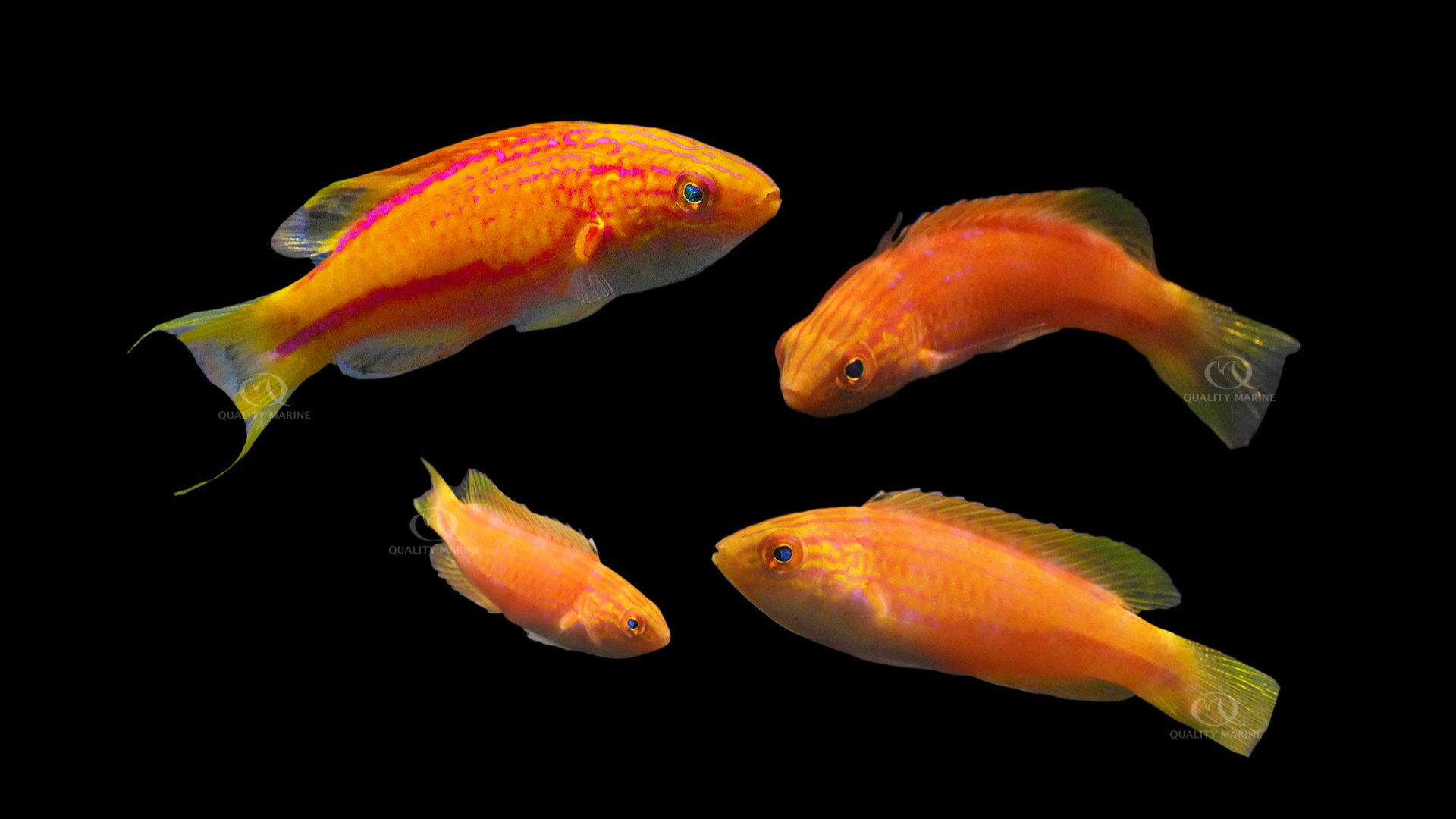The Saintly Squire

The Squire's Wrasse is a “new” fish in the aquarium hobby. While the fish has obviously existed for a very long time indeed, it was only recently classified as its own species by Fenton Walsh in 2014. Its scientific name, Cirrhilabrus squirei, comes from Lyle Squire and family, who were instrumental in finding, capturing and bringing to market the first specimens. It is possible that the hobby had seen Squire's Wrasses before this point, and that they were being imported erroneously as aberrant variations of similar species.
Like all Cirrhilabrus species, Squire's Wrasses males have brighter colors and patterns that the females of the species. They somewhat resemble (the also rare and expensive) Cirrhilabrus johnsoni, though the Squires wrasse males in their terminal coloration will have a bright yellow fish with black and purple highlighting. They are a stunning species, and even the females have better than average color. One of the distinct features of the Squire's wrasse is their tremendous tail filaments; bright yellow gold and impressively long, they are truly royal in appearance. They are one of only four species commonly seen in the aquarium hobby that have such a strong lyretail the others being the aforementioned C. Johnsoni, joined with C. brunneus and C. lunatus.
Even for fairy wrasses, Cirrhilabrus squirei is small, (though slightly larger than the other lyretailed species) never getting much bigger than two and a quarter inch long. They also have a very small range, to our knowledge they have only being found in three fairly remote locations around the Great Barrier Reef in Australia. They are found 90 feet down (down to about 200 feet deep), where they are often found schooling with other similar species. The groups of these fish will feed on planktonic foods suspended above the cover of coral heads.
This minute range, combined with the remote nature and challenging depth make finding Cirrhilabrus squirei in your Local Fish Store a lot like winning the lottery, this fish just does not show up that often. Their stunning coloration and fin form add to the desirability. Add in that they are actually pretty straightforward to keep, and you have a fish that is well deserving of the title “holy grail”.

Keeping Squire's wrasse presents only a couple challenges. Your best pathway to success is to have a well-established aquarium with very stable parameters in regard to salinity, temperature and pH, with only trace levels of nitrates. The primary challenge for them is that this is a deepwater fish, which is not used to bright lighting and a lot of nearby activity. As such it may take some patience to get them to recognize you as a feeder and thus stop hiding at feed times. Providing your fish with elaborate rockwork and a multitude of hiding places will actually make them more visible more of the time as they feel more secure in their surroundings.
We have good luck feeding them a meaty mix of food in house and we always add a small amount of appropriately sized pellet foods from Nutramar to this mix, which they generally start to take after a few meals. This is important as we feed twice a day and we see this schedule as a requisite for success in keeping these (and truthfully any Cirrhilabrus.) Getting your fish accustomed to having pellet foods allows you to use an auto-feeder for one or more of their daily feedings.
Squire's wrasses are extremely unlikely to bother your corals or invertebrates of any kind. For those of you putting them into aquariums that have items with high light demands like Tridacna Clams and SPS Corals, you'll want to acclimate your new Squire's Wrasse to this high lighting scenario gently. The best way to do this is in your quarantine tank, start with an hour or two of bright light and then, slowly adjust the hours of the lighting there to match your display tank. Another thing that helps these fish acclimate quicker is to keep them with other fairy wrasses. While they might be somewhat aggressive with other males, keeping them with other females, even other females from other species of Cirrhilabrus will help them acclimate more quickly. In large enough aquaria, with enough females, they can be kept with other male Cirrhilabrus as well. We suggest at least 3 females for every male if possible and when stock is available to do so, we sell them in these packages. The Squire's Wrasse is a very peaceful fish, and other tank mates you choose should be chosen with this in mind. The long flowing tail and the skittish nature means they will be picked on (and picked at) by more pugnacious fish. They are also champion jumpers, and we STRONGLY suggest keeping a lid on your display. Good tank mates would be Firefish, Clowns, Cardinals etc. Avoid fish like Damsels, Triggers, Puffers etc.
Here at Quality Marine, we've been your source for unbelievably cool and rare things for over four decades (in addition to your source for the highest quality everything as well!). We're very excited to be able to say today that there is a limited number of Squire Wrasses available to you through your Local Fish Store, right now. Call them, the time for your Holy Grail Wrasse has arrived.